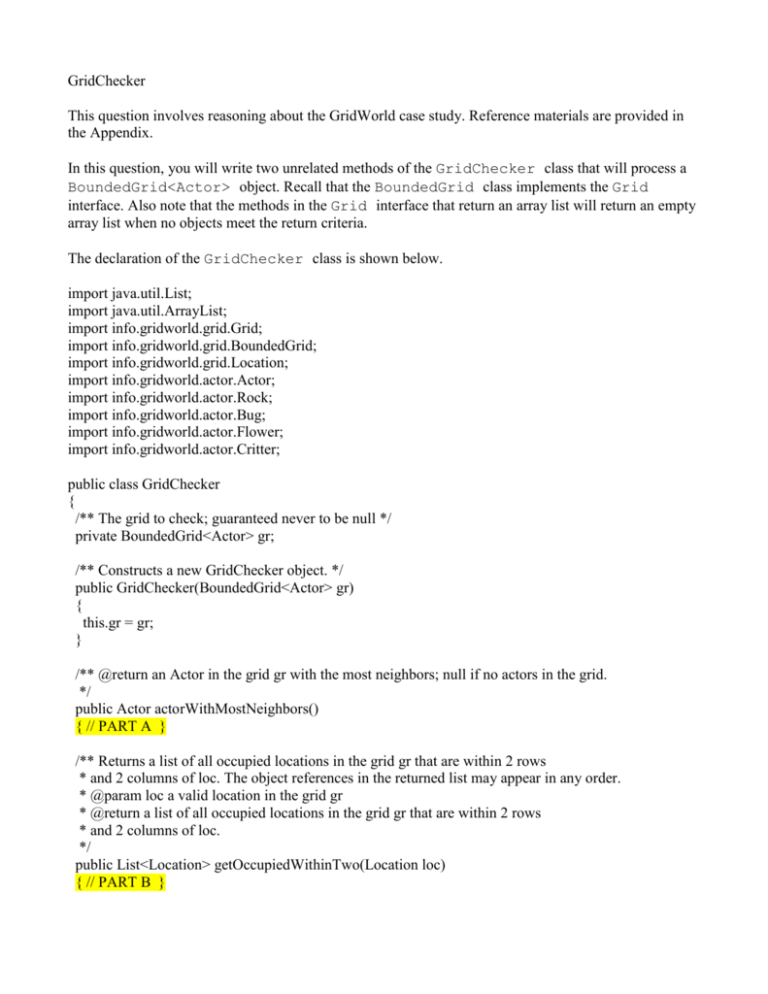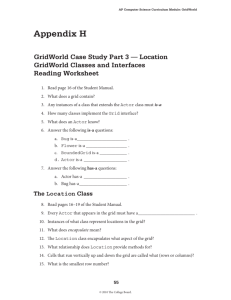GridChecker This question involves reasoning about the GridWorld
advertisement

GridChecker
This question involves reasoning about the GridWorld case study. Reference materials are provided in
the Appendix.
In this question, you will write two unrelated methods of the GridChecker class that will process a
BoundedGrid<Actor> object. Recall that the BoundedGrid class implements the Grid
interface. Also note that the methods in the Grid interface that return an array list will return an empty
array list when no objects meet the return criteria.
The declaration of the GridChecker class is shown below.
import java.util.List;
import java.util.ArrayList;
import info.gridworld.grid.Grid;
import info.gridworld.grid.BoundedGrid;
import info.gridworld.grid.Location;
import info.gridworld.actor.Actor;
import info.gridworld.actor.Rock;
import info.gridworld.actor.Bug;
import info.gridworld.actor.Flower;
import info.gridworld.actor.Critter;
public class GridChecker
{
/** The grid to check; guaranteed never to be null */
private BoundedGrid<Actor> gr;
/** Constructs a new GridChecker object. */
public GridChecker(BoundedGrid<Actor> gr)
{
this.gr = gr;
}
/** @return an Actor in the grid gr with the most neighbors; null if no actors in the grid.
*/
public Actor actorWithMostNeighbors()
{ // PART A }
/** Returns a list of all occupied locations in the grid gr that are within 2 rows
* and 2 columns of loc. The object references in the returned list may appear in any order.
* @param loc a valid location in the grid gr
* @return a list of all occupied locations in the grid gr that are within 2 rows
* and 2 columns of loc.
*/
public List<Location> getOccupiedWithinTwo(Location loc)
{ // PART B }
public static void main(String[] args)
{
BoundedGrid<Actor> grid1 = new BoundedGrid<Actor>(5, 5);
(new Rock()).putSelfInGrid(grid1, new Location(2, 1));
(new Bug()).putSelfInGrid(grid1, new Location(2, 2));
(new Rock()).putSelfInGrid(grid1, new Location(2, 3));
GridChecker gc = new GridChecker(grid1);
System.out.println(gc.actorWithMostNeighbors());
BoundedGrid<Actor> grid2 = new BoundedGrid<Actor>(5, 5);
(new Rock()).putSelfInGrid(grid2, new Location(1, 1));
(new Critter()).putSelfInGrid(grid2, new Location(2, 1));
(new Bug()).putSelfInGrid(grid2, new Location(2, 2));
(new Rock()).putSelfInGrid(grid2, new Location(2, 4));
gc = new GridChecker(grid2);
System.out.println(gc.actorWithMostNeighbors());
BoundedGrid<Actor> grid3 = new BoundedGrid<Actor>(5, 5);
(new Flower()).putSelfInGrid(grid3, new Location(1, 1));
(new Bug()).putSelfInGrid(grid3, new Location(2, 3));
gc = new GridChecker(grid3);
System.out.println(gc.actorWithMostNeighbors());
BoundedGrid<Actor> grid4 = new BoundedGrid<Actor>(7, 7);
(new Rock()).putSelfInGrid(grid4, new Location(0, 0));
(new Bug()).putSelfInGrid(grid4, new Location(3, 2));
(new Rock()).putSelfInGrid(grid4, new Location(3, 3));
(new Critter()).putSelfInGrid(grid4, new Location(5, 4));
(new Critter()).putSelfInGrid(grid4, new Location(5, 6));
gc = new GridChecker(grid4);
System.out.println(gc.getOccupiedWithinTwo(new Location(1, 1)));
System.out.println(gc.getOccupiedWithinTwo(new Location(0, 0)));
System.out.println(gc.getOccupiedWithinTwo(new Location(3, 3)));
System.out.println(gc.getOccupiedWithinTwo(new Location(5, 4)));
System.out.println(gc.getOccupiedWithinTwo(new Location(5, 6)));
}
}
(a) The method actorWithMostNeighbors returns an Actor in the grid gr that has the most neighbors. A
neighbor of a given actor is another actor that occupies any of the given actor's 8 adjacent locations.
Consider the following examples.
In Example 1, the method actorWithMostNeighbors will return the Actor (in this case a bug)
in location (2, 2). In Example 2, there are three Actor objects that have the same largest number of
neighbors—the rock in location (1, 1), the critter in location (2, 1), and the bug in location (2, 2). In this
case, any one of those three Actor objects may be returned. Similarly, either of the Actor objects
shown in Example 3 could be returned. If there are no Actor objects in the grid, the method returns
null.
(b) The method getOccupiedWithinTwo returns a list containing all occupied locations in the grid
gr that are within 2 rows and 2 columns of the parameter loc. The location loc is not included in
the returned list, even if that location is occupied. The object references in the returned list may appear
in any order.
For example, consider the following grid. The table shows the result of getOccupiedWithinTwo(loc) for
several locations.
loc
getOccupiedWithinTwo(loc)
(1, 1)
[(0, 0), (3, 2), (3, 3)]
(0, 0)
An empty list is returned.
(3, 3)
[(3, 2), (5, 4)]
(5, 4)
[(3, 2), (3, 3), (5, 6)]
(5, 6)
[(5, 4)]







